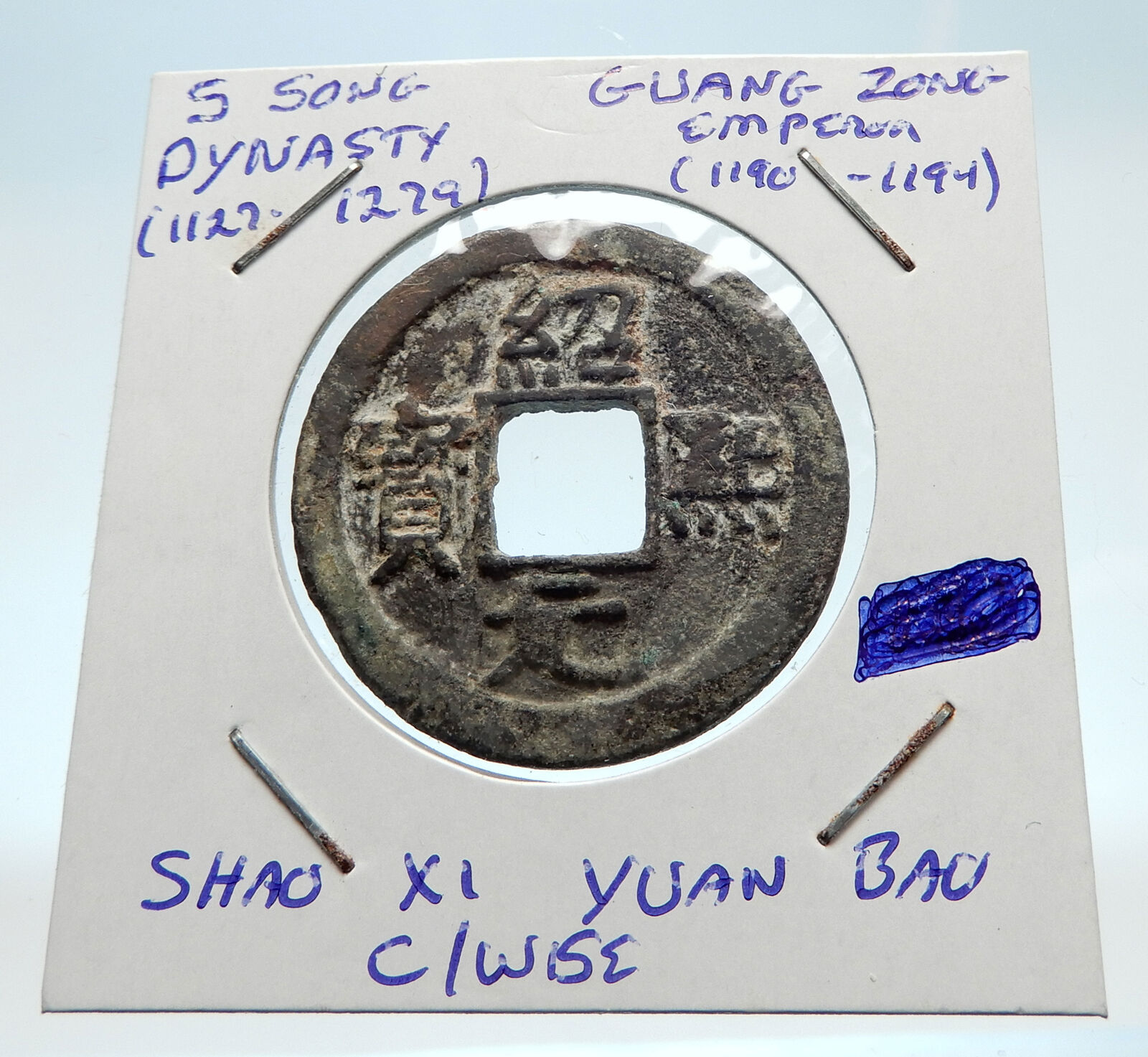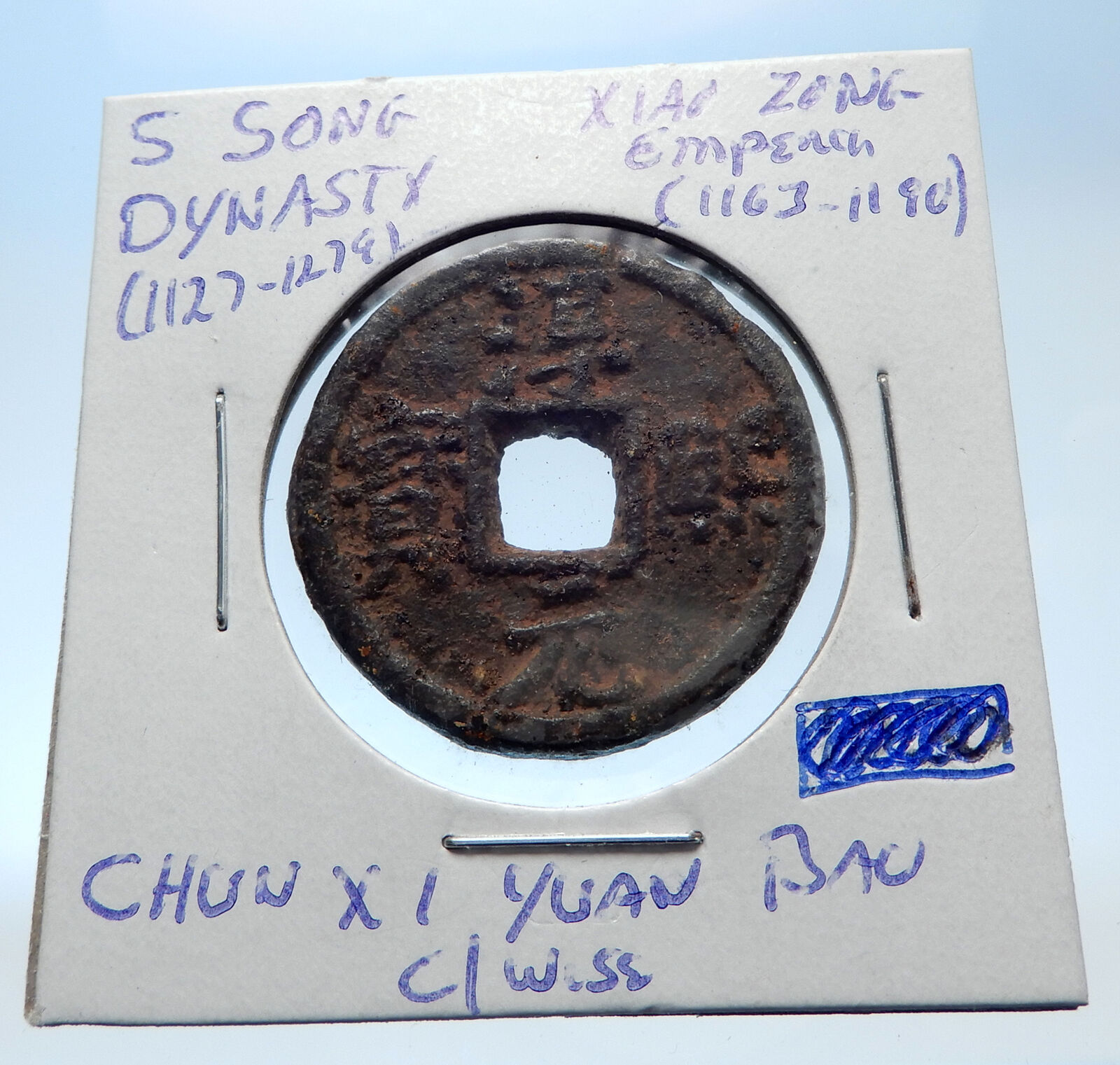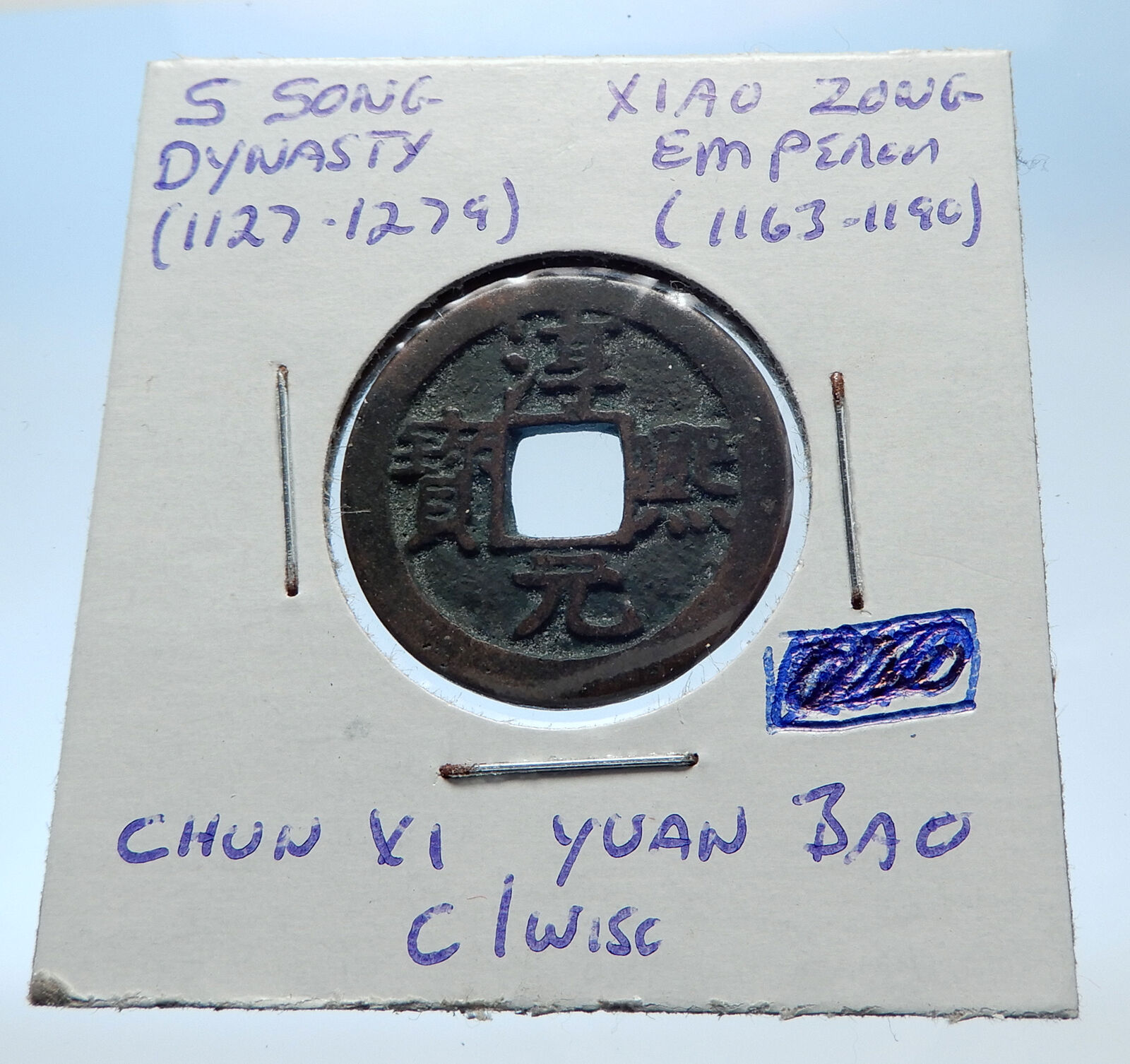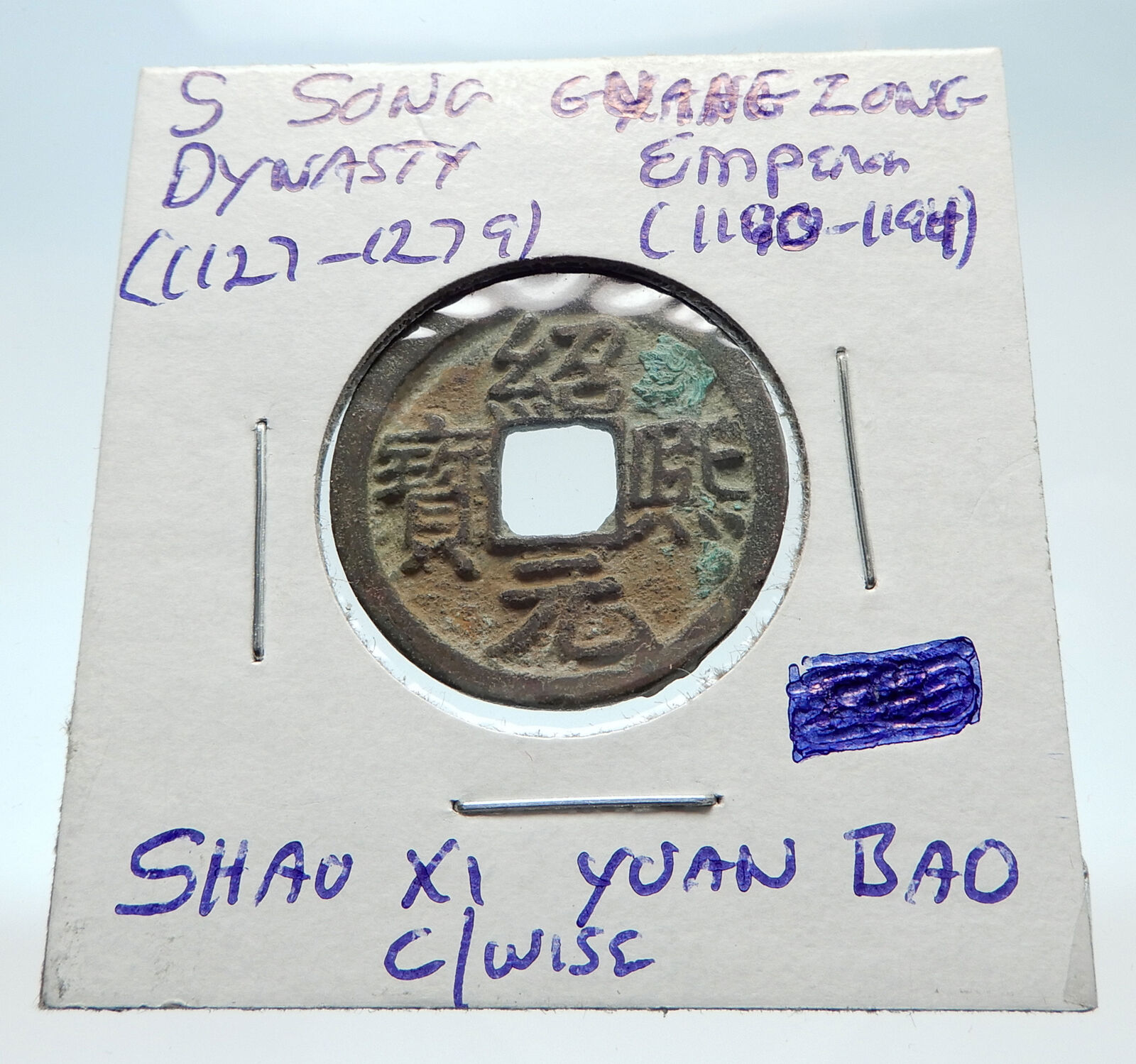|
China –
Sui Dynasty (581-618 AD)
Emperor Wen Ti (589-604 AD)
Bronze Wu Zhu
Cash Token
23mm, Struck 589-604 AD
Reference: H# 10.26
Symbols.
You are bidding on the exact item pictured, provided with a Certificate of Authenticity and Lifetime Guarantee of Authenticity.
 The Emperor Wen of Sui (隋文帝; 21 July 541 – 13 August 604), personal name Yang Jian (楊堅), Xianbei name Puliuru Jian (普六茹堅), alias Narayana (Chinese: 那羅延; pinyin: Nàluóyán) deriving from Buddhist terms, was the founder and first emperor of the Chinese Sui dynasty (581–618 AD). He was a hard-working administrator and a micromanager. The Book of Sui records him as having withdrawn his favour from the Confucians, giving it to “the group advocating Xing-Ming and authoritarian government.”[1] As a Buddhist, he encouraged the spread of Buddhism through the state. He is regarded as one of the most important emperors in ancient Chinese history, reunifying China in 589 after centuries of division since the fall of the Western Jin dynasty in 316. During his reign, the construction of the Grand Canal began. The Emperor Wen of Sui (隋文帝; 21 July 541 – 13 August 604), personal name Yang Jian (楊堅), Xianbei name Puliuru Jian (普六茹堅), alias Narayana (Chinese: 那羅延; pinyin: Nàluóyán) deriving from Buddhist terms, was the founder and first emperor of the Chinese Sui dynasty (581–618 AD). He was a hard-working administrator and a micromanager. The Book of Sui records him as having withdrawn his favour from the Confucians, giving it to “the group advocating Xing-Ming and authoritarian government.”[1] As a Buddhist, he encouraged the spread of Buddhism through the state. He is regarded as one of the most important emperors in ancient Chinese history, reunifying China in 589 after centuries of division since the fall of the Western Jin dynasty in 316. During his reign, the construction of the Grand Canal began.
As a Northern Zhou official, Yang Jian served with apparent distinction during the reigns of Emperor Wu of Northern Zhou and Emperor Xuan of Northern Zhou. When the erratic Emperor Xuan died in 580, Yang, as his father-in-law, seized power as regent. After defeating the general Yuchi Jiong, who resisted him, he seized the throne for himself, establishing the new Sui Dynasty (as its Emperor Wen). He was the first Chinese ruler to rule the entire North China after the Xianbei clans conquered that area from the Liu Song dynasty (not counting the brief reconquest of that region by Emperor Wu of Liang).
Generally speaking, Emperor Wen’s reign was a great period of prosperity, not seen since the Han dynasty. Economically, the dynasty prospered. It was said that there was enough food stored for 50 years. The military was also powerful. At the beginning of his reign, Sui faced the threat of the Göktürks to the north, and neighbored Tibetan tribes to the west, Goguryeo in the northeast, and Champa (Linyi) threatening the south. By the end of Emperor Wen’s reign, the Göktürks had split into an eastern and a western kaganate, the eastern one being nominally submissive to Sui, as was Goguryeo. Champa was defeated and, while not conquered, did not remain a threat.
Emperor Wen is also famous for having the fewest concubines for an adult Chinese emperor. (Emperor Fei of Western Wei and the Ming dynasty Hongzhi Emperor were the only two perpetually monogamous Chinese emperors.) Emperor Wen was known for having only two concubines (although he might have had additional concubines not documented by traditional historians), with whom he might not have had sexual relations until after the death in 602 of his wife Empress Dugu, whom he loved and respected deeply.
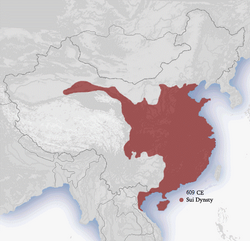 The Sui dynasty ( Chinese: 隋朝; pinyin: Suí cháo) was a short-lived imperial dynasty of China of pivotal significance. The Sui unified the Northern and Southern dynasties and reinstalled the rule of ethnic Han in the entirety of China proper, along with sinicization of former nomadic ethnic minorities (Five Barbarians) within its territory. It was succeeded by the Tang dynasty, which largely inherited its foundation. The Sui dynasty ( Chinese: 隋朝; pinyin: Suí cháo) was a short-lived imperial dynasty of China of pivotal significance. The Sui unified the Northern and Southern dynasties and reinstalled the rule of ethnic Han in the entirety of China proper, along with sinicization of former nomadic ethnic minorities (Five Barbarians) within its territory. It was succeeded by the Tang dynasty, which largely inherited its foundation.
Founded by Emperor Wen of Sui, the Sui dynasty capital was Chang’an (which was renamed Daxing, modern Xi’an, Shaanxi) from 581–605 and later Luoyang (605–618). Emperors Wen and his successor Yang undertook various centralized reforms, most notably the equal-field system, intended to reduce economic inequality and improve agricultural productivity; the institution of the Five Departments and Six Board (五省六曹 or 五省六部) system, which is a predecessor of Three Departments and Six Ministries system; and the standardization and re-unification of the coinage. They also spread and encouraged Buddhism throughout the empire. By the middle of the dynasty, the newly unified empire entered a golden age of prosperity with vast agricultural surplus that supported rapid population growth.
A lasting legacy of the Sui dynasty was the Grand Canal. With the eastern capital Luoyang at the center of the network, it linked the west-lying capital Chang’an to the economic and agricultural centers of the east towards Jiangdu (now Yangzhou, Jiangsu) and Yuhang (now Hangzhou, Zhejiang), and to the northern border near modern Beijing. While the pressing initial motives were for shipment of grains to the capital, transporting troops, and military logistics, the reliable inland shipment links would facilitate domestic trade, flow of people and cultural exchange for centuries. Along with the extension of the Great Wall, and the construction of the eastern capital city of Luoyang, these mega projects, led by an efficient centralized bureaucracy, would amass millions of conscripted workers from the large population base, at heavy cost of human lives.
After a series of costly and disastrous military campaigns against Goguryeo, one of the Three Kingdoms of Korea, ended in defeat by 614, the dynasty disintegrated under a series of popular revolts culminating in the assassination of Emperor Yang by his minister, Yuwen Huaji in 618. The dynasty, which lasted only thirty-seven years, was undermined by ambitious wars and construction projects, which overstretched its resources. Particularly, under Emperor Yang, heavy taxation and compulsory labor duties would eventually induce widespread revolts and brief civil war following the fall of the dynasty.
The dynasty is often compared to the earlier Qin dynasty for unifying China after prolonged division. Wide-ranging reforms and construction projects were undertaken to consolidate the newly unified state, with long-lasting influences beyond their short dynastic reigns.
Wu Zhu (Chinese: 五銖) is a type of Chinese cash coin produced from the Han dynasty in 118 BC when they replaced the earlier San Zhu (三銖; “Three Zhu”) cash coins, which had replaced the Ban Liang (半兩) cash coins a year prior, until they themselves were replaced by the Kaiyuan Tongbao (開元通寳) cash coins of the Tang dynasty in 621 AD. The name Wu Zhu literally means “five zhu” which is a measuring unit officially weighing about 4 grams however in reality the weights and sizes of Wu Zhu cash coins varied over the years. During the Han dynasty a very large quantity of Wu Zhu coins were cast but their production continued under subsequent dynasties until the Sui.
The production of Wu Zhu cash coins was briefly suspended by Wang Mang during the Xin dynasty but after the reestablishment of the Han dynasty, the production of Wu Zhu cash coins resumed, and continued to be manufactured long after the fall of the Eastern Han dynasty for another 500 years. Minting was definitively ended in 618 with the establishment of the Tang dynasty. Wu Zhu cash coins were cast from 118 BC to 618 AD having a span of 736 years, which is the longest for any coin in the history of the world.
Cash was a type of coin of China and East Asia, used from the 4th century BC until the 20th century AD. Originally cast during the Warring States period, these coins continued to be used for the entirety of Imperial China as well as under Mongol, and Manchu rule. The last Chinese cash coins were cast in the first year of the Republic of China. Generally most cash coins were made from copper or bronze alloys, with iron, lead, and zinc coins occasionally used less often throughout Chinese history. Rare silver and gold cash coins were also produced. During most of their production, cash coins were cast but, during the late Qing dynasty, machine-struck cash coins began to be made. As the cash coins produced over Chinese history were similar, thousand year old cash coins produced during the Northern Song dynasty continued to circulate as valid currency well into the early twentieth century.
In the modern era, these coins are considered to be Chinese “good luck coins”; they are hung on strings and round the necks of children, or over the beds of sick people. They hold a place in various superstitions, as well as Traditional Chinese medicine, and Feng shui. Currencies based on the Chinese cash coins include the Japanese mon, Korean mun, Ryukyuan mon, and Vietnamese văn.
|





 The Emperor Wen of Sui (隋文帝; 21 July 541 – 13 August 604), personal name Yang Jian (楊堅), Xianbei name Puliuru Jian (普六茹堅), alias Narayana (Chinese: 那羅延; pinyin: Nàluóyán) deriving from Buddhist terms, was the founder and first emperor of the Chinese Sui dynasty (581–618 AD). He was a hard-working administrator and a micromanager. The Book of Sui records him as having withdrawn his favour from the Confucians, giving it to “the group advocating Xing-Ming and authoritarian government.”[1] As a Buddhist, he encouraged the spread of Buddhism through the state. He is regarded as one of the most important emperors in ancient Chinese history, reunifying China in 589 after centuries of division since the fall of the Western Jin dynasty in 316. During his reign, the construction of the Grand Canal began.
The Emperor Wen of Sui (隋文帝; 21 July 541 – 13 August 604), personal name Yang Jian (楊堅), Xianbei name Puliuru Jian (普六茹堅), alias Narayana (Chinese: 那羅延; pinyin: Nàluóyán) deriving from Buddhist terms, was the founder and first emperor of the Chinese Sui dynasty (581–618 AD). He was a hard-working administrator and a micromanager. The Book of Sui records him as having withdrawn his favour from the Confucians, giving it to “the group advocating Xing-Ming and authoritarian government.”[1] As a Buddhist, he encouraged the spread of Buddhism through the state. He is regarded as one of the most important emperors in ancient Chinese history, reunifying China in 589 after centuries of division since the fall of the Western Jin dynasty in 316. During his reign, the construction of the Grand Canal began. The Sui dynasty ( Chinese: 隋朝; pinyin: Suí cháo) was a short-lived imperial dynasty of China of pivotal significance. The Sui unified the Northern and Southern dynasties and reinstalled the rule of ethnic Han in the entirety of China proper, along with sinicization of former nomadic ethnic minorities (Five Barbarians) within its territory. It was succeeded by the Tang dynasty, which largely inherited its foundation.
The Sui dynasty ( Chinese: 隋朝; pinyin: Suí cháo) was a short-lived imperial dynasty of China of pivotal significance. The Sui unified the Northern and Southern dynasties and reinstalled the rule of ethnic Han in the entirety of China proper, along with sinicization of former nomadic ethnic minorities (Five Barbarians) within its territory. It was succeeded by the Tang dynasty, which largely inherited its foundation.

